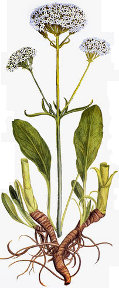|
A large, bold plant that announces itself not only through its size but its scent, valerian's root contains Jupiter's planetary metal (tin). This magick herb is also kingly in its name, which was taken from one of the caesars. Considered to be Water of Water in the Golden Dawn system, it is very Earthy, too. Associated with Samhain and Yule, this European herb was favored in Eclectic medicine for treatment of short-term depression; this coincides with its ritual use for relieving self-condemnation and developing self-acceptance. This is a great herb for invoking paternal protection, for purification, and for consecrating thuribles. You can make a nice valerian incense by combining it 2:1 with white sandalwood. This herb is especially good in forest blends or for evoking animal spirits without using animal ingredients. Cats love it. Mundane Uses of Valerian A relaxant that is not addicting, traditionally it is considered a good remedy for nervousness, insomnia, and body tension. It should not be used during pregnancy, though. Because valerian is warming rather than cooling, excessive doses cause headaches, giddiness, and agitation, proving the maxim that what soothes in small doses stimulates in large ones. Valerian is also known as vandal root, all-heal, St. George's herb, setwall, setewale, fu, phu, capon's tail, vandal root, van, cat's valerian, amantilla, theriacaria, marinella, genicularis, and terdina. |
Organic valerian root
Uses in Witchcraft & Magic: Celebrating Samhain & Yule © 2004-2024 Alchemy Works; No reproduction without permission |
 Valerian Root (Vandal Root)
Valerian Root (Vandal Root)